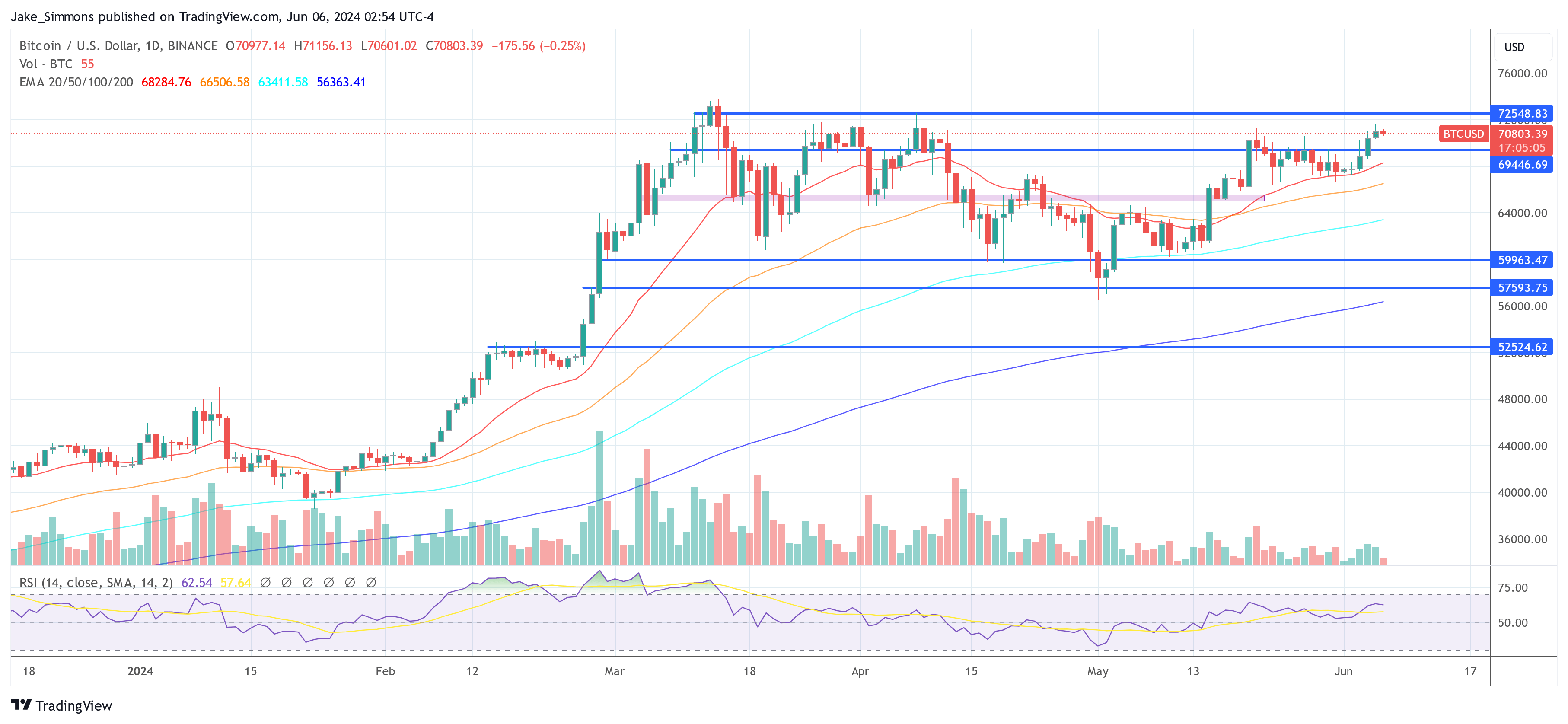The US spot Bitcoin Exchange-Traded Funds (ETFs) have been witnessing a historic run of inflows, marking 17 consecutive days of net additions. On a particularly notable Tuesday, these ETFs observed inflows totaling a staggering $886.6 million, ranking it as the second-highest single-day influx since their introduction.
This was followed by another significant day of inflows yesterday, amounting to $488.1 million, with notable contributions from major financial players like Fidelity ($220.6 million), Blackrock ($155.1 million), and Ark ($71.4 million). Despite these hefty capital injections, the price of Bitcoin has demonstrated a relatively subdued response, inching from $68,000 to $71,000 since the beginning of the week.
The muted price movement in the face of substantial ETF inflows has puzzled many market participants and analysts. Typically, such inflows are expected to exert a stronger upward pressure on Bitcoin prices. However, the observed price dynamics suggest that other counteracting factors might be at play.
Why Is The Bitcoin Price Not Going Higher?
Crypto trading analytics platform The Kingfisher offered an explanation via a post on X, suggesting that a carry trade strategy might be influencing the price dynamics. According to their analysis, “The BTC ETF inflows didn’t affect the price as much as you hoped it would? It might be due to a carry trade being loaded up. Short Futures + Buy Spot/ETF.”
Related Reading
A carry trade in this context involves shorting Bitcoin futures while simultaneously buying spot Bitcoin or Bitcoin ETF shares. This strategy can hedge against potential price volatility and exploit discrepancies between futures prices and spot prices.
JJ the Janitor (@JLabsJanitor) further elaborated on the strategy’s mechanics. He drew parallels with behaviors visualized on the PANDA Terminal charts, explaining, “When big boys want BTC spot filled they sell futures contracts to bring price into bids. When they’re filled + ready to let it rip they close those shorts, hence the inverse correlation on True Open Interest (OI).”
His remarks hint at strategic market manipulations that, while legal, blur the lines between savvy investment tactics and potential ethical concerns. His follow-up tweet, “Market manipulation or savvy investment strategy….what’s the difference?” challenges the narrative by questioning the ethical implications of such strategies.
Related Reading
The discussion prompted further scrutiny from the crypto community. X user Sahra critiqued the practical implementation of the carry trade, noting, “Carry trade should suppress funding rates naturally. Long spot pressure against the perpetual should in theory cause perpetual rates to drop (all else being equal) as perpetual would begin to lag spot. Everything else makes sense, but these rates are far too low to justify a carry IMO.”
This comment points to the complexities of carry trades, where expected outcomes like suppressed funding rates are not aligning with market observations, suggesting that other forces might be influencing the market.
The Kingfisher responded to Sahra’s skepticism, acknowledging the anomaly: “That’s right, the funding remains fairly positive though. This suggests that while a carry trade could be in play, it’s not the dominant force in the market. Other factors, like bullish sentiment or other buying pressures, might be offsetting the expected downward pressure on funding rates from the carry trade.”
At press time, BTC traded at $70,803.

Featured image created with DALL·E, chart from TradingView.com
- SEO Powered Content & PR Distribution. Get Amplified Today.
- PlatoData.Network Vertical Generative Ai. Empower Yourself. Access Here.
- PlatoAiStream. Web3 Intelligence. Knowledge Amplified. Access Here.
- PlatoESG. Carbon, CleanTech, Energy, Environment, Solar, Waste Management. Access Here.
- PlatoHealth. Biotech and Clinical Trials Intelligence. Access Here.
- Source: https://www.newsbtc.com/news/bitcoin/bitcoin-price-manipulated-small-impact-etf-inflows/



